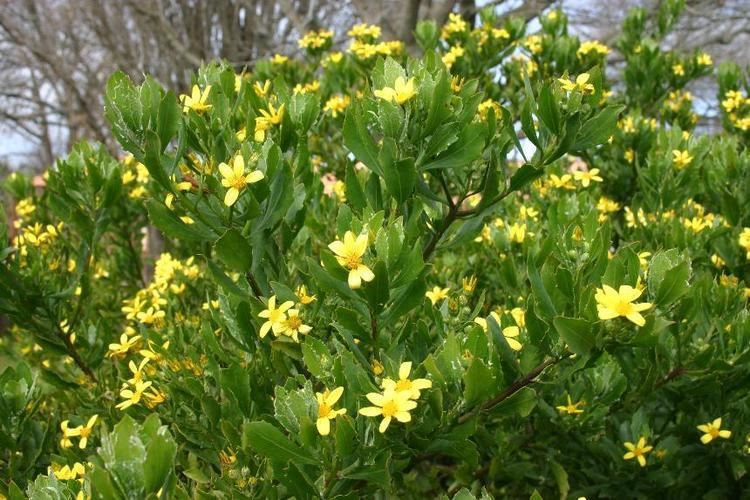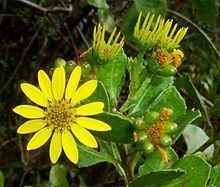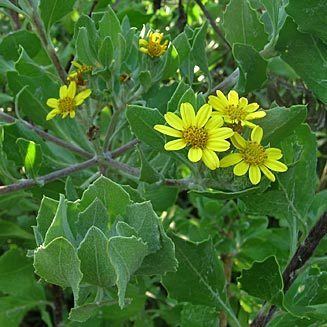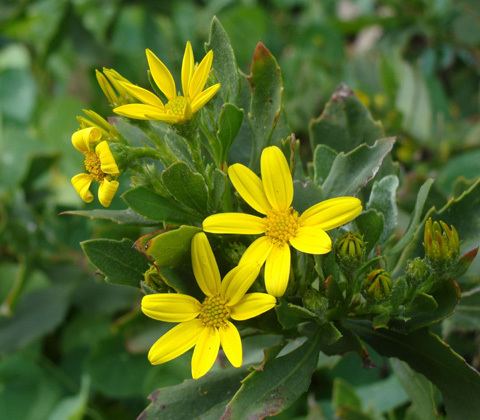Tribe Calenduleae | Rank Species | |
 | ||
Scientific name Chrysanthemoides monilifera Similar Chrysanthemoides, Asparagus asparagoides, Daisy family, Nassella trichotoma, Lycium ferocissimum | ||
Bitou bush chrysanthemoides monilifera bash
Chrysanthemoides monilifera (subspecies of which are known as Boneseed and Bitou Bush in Australasia, or Bietou, Tick Berry, Bosluisbessie, or Weskusbietou in South Africa) is an evergreen flowering shrub or small tree, usually with woolly, dull, serrate, oval leaves, but with glossy round leaves in the subsp. rotundata, belonging to the Asteraceae (daisy) family. It is native to South Africa, such as the Cape Flats Dune Strandveld habitat.
Contents
- Bitou bush chrysanthemoides monilifera bash
- Taxonomy
- Description
- Distribution and habitat
- Australia
- New Zealand
- Impact
- Control
- References

The plant has become a major environmental weed and invasive species in Australia and New Zealand.
Taxonomy
Chrysanthemoides monilifera is one of only two members of the genus Chrysanthemoides, the other is Chrysanthemoides incana.
C. monilifera has six recognized subspecies:

In Australia, C. m. ssp. monilifera is known by the common name 'Boneseed', while C. m. ssp. rotundata is known by the common name 'Bitou Bush'. In New Zealand subspecies are not distinguished and C. monilifera is simply known as 'Boneseed'.

C. monilifera was first described by Carl Linnaeus in 1754 under the name Osteospermum monilifera, however it was given its current binomial name in 1943 by T. Norlindh.

The species name monilifera comes from the Latin, monile, meaning necklace or collar, referring to the shiny fruit arranged around the flowers like a necklace.
Description
Boneseed is a perennial, woody, upright shrub, growing to 3 m (9.8 ft), although occasionally taller. It is a member of the Asteraceae (daisy) family and has showy, bright yellow flowers in swirls of 5-8 'petals' (ray florets) up to 30 mm (1.2 in) in diameter. Fruit are berry-like, spherical at around 8 mm in diameter, and turn dark-brown to black with a bone-coloured seed inside of 6–7 mm diameter. Leaves are 2–6 cm (0.79–2.36 in) long by 1.5–5 cm (0.59–1.97 in) wide, oval tapering to the base with irregularly serrate margins.
Bitou Bush can be distinguished from Boneseed in part due to its more rounded sprawling habit to 1.5–2 m (4.9–6.6 ft), less noticeably toothy leaf margins and seeds that are egg-like rather than spherical.
Both Boneseed and Bitou Bush hybridise readily, however, so examples of plants demonstrating a fusion of traits is possible.
Distribution and habitat
Chrysanthemoides monilifera occurs naturally in coastal areas of South Africa, reaching into southern Namibia and Mozambique. The most widespread subspecies in South Africa is pisifera. Subspecies rotundata is concentrated along the eastern coast of South Africa from its southern tip through to the Mozambique border. Subspecies monilifera is concentrated around Cape Town and the Cape Peninsula on South Africa's south western coast.
Australia
In Australia, subspecies rotundata (Bitou Bush) has naturalised along the coast of Queensland and New South Wales, while subspecies monilifera (Boneseed) has naturalised along and near the coast in parts of Victoria and South Australia.
New Zealand
In New Zealand C. monilifera, which is listed on the National Pest Plant Accord, is common in coastal locations throughout the North Island, and can also be found in the South Island in Nelson City, Port Hills (Christchurch) and the Otago Peninsula.
Impact
In Australia, C. monilifera has been particularly successful in invading natural bushland. In part, this is due to the species' ability to establish on relatively nutrient-poor soils and in areas exposed to salt such as coastlines, as well as the ability of the seeds to germinate readily. Disturbances such as fire can assist C. monilifera to spread as the plant produces a large amount of seed that can persist in the soil seed bank for 10 years or more, and this reserve in turn enables the species to quickly recolonize a burnt area.
An individual plant can produce 50,000 seeds a year, about 60% of which are viable. Once germinated, seedlings grow vigorously with dense, bushy growth. This lush growth shades out and displaces slower growing native species that might otherwise occupy the same ecological niche. Rapid, vigorous growth also means that C. monilifera is capable of flowering and setting seed within 12–18 months, making it extremely persistent even in situations where disturbance or regular management activity is common.
Once established, the plant's shallow root system enables it to absorb moisture after light rain before the moisture reaches the roots of more deeply rooted species further limiting opportunities for slower growing species to establish and out-compete C. monilifera over time. Furthermore, outside of Southern Africa the plant has few local, indigenous pathogens or predators to control its growth also reducing the potential for gaps to emerge that might provide opportunities for other species to reestablish. The net consequence of C. monilifera's growth characteristics is that outside of its natural ecosystem it can ultimately form large, dense, unhealthy stands of a single species with extraordinarily poor biodiversity.
The plant can extend its existing range in a variety of ways. Its fruit is attractive to birds, rabbits, other animals and even some insects such as ants, and because seeds are tough and difficult to digest they will often be dispersed in animal droppings. Seeds can also spread on vehicles and equipment, in contaminated soil, in garden waste, along water drainage lines and deliberately by human intervention.
C. monilifera, unlike many other weed species, is not generally considered to be a problem for agricultural productivity due to its sensitivity to trampling as well as being readily grazed by stock.
Control
C. monilifera is potentially susceptible to a range of control strategies, however Burgman and Lindenmayer recommended that the strategy chosen be responsive to the local situation and available resources. Due to its relatively shallow root system removal by hand is an ideal method of control. Where manual removal is impractical many common herbicides can be used, in which case the herbicide is commonly applied directly to the wood of the plant via a cut notch or at the end of a pruned stump. Mechanical removal of C. monilifera by tractor or other machinery can also be effective, however this can be extremely indiscriminate and is only recommended in areas of poor environmental values and minimal erosion risk.
Another method of control available is the use of controlled burns, however there are risks associated with this method. Principally, C. monilifera has higher moisture levels than many Australian indigenous species and therefore in Australia a higher than normal intensity fire is required for burns to be effective. This can in turn have detrimental impacts on indigenous vegetation evolved in response to more frequent, lower intensity fire. Furthermore, fire can trigger regermination from the extensive C. monilifera seed bank, potentially worsening the situation unless a program is implemented to monitor and control C. monilifera seedlings following the burn. If C. monilifera seedlings are removed, however, this can be extremely effective at exhausting the seed bank and minimising the chances of reinfestation.
Various methods of biological control have been attempted, particularly the introduction of insects adapted as natural enemies of C. monilifera such as the Bitou Tip Moth (Comostolopsis germana) and Bitou Seed Fly (Mesoclanis polana). In Australia, while these have had some success in controlling Bitou Bush (ssp. rotundata), to date they have not had similar success in combating Boneseed (ssp. monilifera).
